Marshak Dairy Facility
October 18, 1996 was a festive day for the School. The Marshak Dairy Facility was dedicated at New Bolton Center. This 200-head greenhouse style dairy barn, the first such facility in Pennsylvania, is named in honor of Dr. Robert R. Marshak, the ninth dean of the School. University President Judith Rodin and Dr. Alan M. Kelly, The Gilbert S. Kahn Dean of Veterinary Medicine, welcomed the invitees who included officials of the Commonwealth of Pennsylvania, members of the State House of Representatives and the Senate, representatives of the agricultural communities, members of the University and School community and neighbors of New Bolton Center.
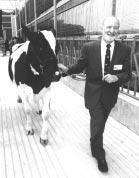
Alumni Day ’96
(page 14)
(continued on page 4)
Commencement

(page 10)

1 39 University of PennsylvaniaFall/Winter 1996/1997 Newsmagazine of the School of Veterinary Medicine
From The Dean
Recently, I came across a revealing piece of history about the School concerning the first Dean, Dr. Rush Shippen Huidekoper.
Huidekoper was a graduate of the Medical Department of the University of Pennsylvania and was an avid horseman. Heeding a lecture delivered in 1807 by his relative Dr. Benjamin Rush to the Medical Department on “The Duty and Advantages of Studying the Diseases of Domestic Animals and the Remidies Proper to Remove Them,” Huidekoper went to France in 1880 to obtain a degree at the world’s second oldest veterinary school, Alfort, just outside Paris. Upon his return he was elected Professor of Internal Pathology and Contagious Diseases and Dean of the Faculty in 1883. The original faculty comprised twelve professors, ten with medical degrees. With Huidekoper they accepted the School’s first class in 1884.
All of this is fairly well known but what is not so well known is that Huidekoper resigned in 1889 due to a conflict with the governor at the time, James A. Beaver. Today,
Governor Beaver’s name is celebrated at Penn State’s football stadium. Huidekoper recognized from the start that a veterinary school at a private university could not succeed without state funding and in 1889 obtained the support of the legislature for an appropriation of $100,000. Unfortunately, this was vetoed by Governor Beaver. Dr. Huidekoper, discouraged by the School’s grim financial situation, stepped down later that year. It was not until 1907 under the leadership of the School’s third Dean, Leonard Pearson, that the School received an appropriation from the Commonwealth. This was in the amount of $100,000 and was used by Pearson to start the Quadrangle Building at the School’s new site at 38th and Woodland Avenue. The original site was a few blocks away at 36th and Pine Street.
The story is interesting for it shows that uncertainty over the appropriation has been a problem for the School from its beginning and has been the undoing of more than one dean. I hope I do not succumb to the same fate and see the present year as a watershed in the School’s relations with the Commonwealth. I say this because for many years, the University has received an appropriation from the Commonwealth known as the General Instruction line in addition to the School’s appropriation. In the current aca-
Dr. Brinster Recipient of Bower Award
Dr. Ralph Brinster, Richard King Mellon Professor of Reproductive Physiology at the School, is the recipient of the 1996 Bower Award and Prize in Science, the richest American prize in science. The Bower Awards are presented annually by the Franklin Institute.
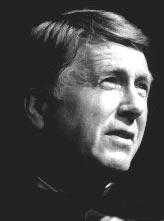
Dr. Brinster is being recognized for his original and highly significant contributions to the field of mammalian embryo development and gene regulation. He was chosen by a prestigious international panel of scientists including Lap-Chee Tsui, Ph.D., professor of molecular genetics in Toronto, Canada; Dr. Pablo Rudomin, M.D., Ph.D., science advisor to the President of Mexico; and Marvin Caruthers, Ph.D., professor of biochemistry at the University of Colorado at Boulder.
Brinster devised elegant experimental
techniques which provided an insight into the early events in the developing embryo and introduced techniques for the production of transgenic — with foreign genes — animals. This ability to experimentally modify the germ line — an animal or plant’s reproductive lineage — and then pass those traits along to the offspring of the altered species is one of the key advances in biology. To accomplish this remarkable milestone in mice depended on being able to maintain and manipulate in vitro female germ cells, the fertilized egg and early embryos in an uncomplicated and efficient manner. Beginning with his Ph.D. thesis in the early 1960’s, which resulted in the development of a simple system to culture mouse eggs (one of the most cited papers in the life sciences), Dr. Brinster’s lab has provided the means to
demic year the General Instruction line amounts to $9 million. Traditionally, the University’s appropriation has been more difficult to justify in Harrisburg than that for the Veterinary School due, in part, to the University’s $2 billion endowment and the competing claims from universities in other parts of the Commonwealth. Because of these continuing difficulties and in recognition of the chronic underfunding of the Veterinary School, the University Administration has made the pragmatic decision to forego the General Instruction line in FY’98 and focus the entire state appropriation request with the Veterinary School.
This presents a remarkable opportunity for the School that should help us secure more predictable funding from the Commonwealth and at the same time, meet some of the School’s most pressing needs. These include reducing the effective rate of tuition and addressing a $4.5 million deferred maintenance budget at New Bolton Center. The next several months will require detailed negotiations in Harrisburg but I see this as the best opportunity in a long time to finally lay Dr. Huidekoper’s ghost to rest.
Alan M. Kelly, B.V.Sc., M.R.C.V.S., Ph.D.
The Gilbert S. Kahn Dean of Veterinary Medicine
carry out many of the exciting experiments in the field of developmental biology. One dramatic application of this method was the introduction of a gene for rat growth hormone into the germ line of mice that produced “super” mice.
In his most recent work, Dr. Brinster took frozen rat stem cells — the cells that make sperm — thawed them and grew them in living mice. The mice produced rat sperm along with their own. His continued leadership in the field of transgenic biotechnology promises significant advances in animal husbandry and human health.
The Bower Awards will be presented during a convocation ceremony on May 1, 1997. There will also be a series of lectures and symposia on biotechnology in conjunction with this event.
2
DRPA Grant
The Delaware River Port Authority re cently awarded a grant of $450,000 to the School to study the feasibility of establishing a state-of-the-art aquaculture facility and fish processing plant at the Philadelphia Navy Yard to bring many jobs to the area and utilize the existing buildings there.
“The Navy Yard, located in the center of the East Coast market, has transportation links, buildings, space and access to a labor force,” said Dr. Leon Weiss, Lambert Professor of Cell Biology at the School, and leader of the study. “It is well-suited for a major aquaculture facility.”
This would include not only facilities to raise fish to market size in closed, recirculating systems but also other facilities such as hatcheries to provide stock for the tanks and the ponds on farms in Pennsylvania and New Jersey. Also included would be a processing plant to filet, pack and freeze the product and a feed mill to produce fish food.
The feasibility study is an interdisciplinary, multi-school ef fort led by the School of Veterinary Medicine The Wharton School will analyze the financial side of the venture and provide business and marketing expertise to assess the commercial prospects of aquaculture industry at the Navy Yard. Penn’s School of Engineering will study the model of a closed, recirculating system to be set up at the Philadelphia campus and refine and improve it to make such a system commercially viable At New Bolton Center the farm pond will be improved and stocked with fish to provide all-year, summer and winter fish crops. It will be a “living laboratory” to develop protocols so that farmers in Pennsylvania and New Jersey can utilize their existing ponds for raising another cash crop. Plans are also being made to have additional aquaculture research conducted at New Bolton Center, including closed, recirculating systems.
Fish, always thought of as an abundant food resource, are not as plentiful now due to many factors, among them pollution and overfishing. New technologies have made possible large scale, intensive fishing. Fleets, with the help of sophisticated instruments, accurately lo-
cate schools of fish and gigantic, lightweight nets haul aboard whatever is in their paths. In recent years vast quantities of fish have been removed from the oceans, leaving many species in a very precarious position. Already, large ocean areas are off-limit to commercial fishing so that fish populations there may regenerate and become plentiful again. Meanwhile, people’s appetite for fish is growing.
Commercial aquaculture is trying to fill the void. Salmon are raised in giant pens, catfish and trout are raised in ponds. Other fish
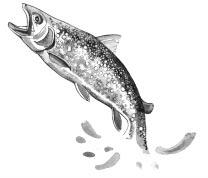
ceive fish. Dr. David Nunamaker, chair of the Department of Clinical StudiesNew Bolton Center, heads the working group on pond farming. Dr. David Galligan from the School’s Center for Animal Health and Productivity is a member of the group as are representatives from the Stroud Water Research Center and the Maryland Farm Extension Service of the University of Maryland.
The School’s Department of Pathobiology will provide expertise in pathology and the group at Woods Hole, headed by Dr. Donald Abt, will also be involved in the project Veterinary students too will play a role in the study They will be able to gain hands-on experience in pond fish farming and in the tank system.
are raised in tanks inside buildings, though this has not yet become profitable. Aquaculture is a developing industry and the School, through its Aquavet® program, has trained veterinarians in aquatic veterinary medicine for 20 years during intensive summer programs at Woods Hole, MA.
“We are positioned to lead this ef fort,” said Dr. Weiss. “Not only do we have extensive experience in aquatic veterinary medicine, but the other schools in the University are a great resource for this study. The Wharton School will provide the business and marketing expertise. The School of Engineering will assess existing closed, recirculating systems and together with veterinarians will develop a commercially feasible prototype that could be used in the Navy Yard.”
A closed, recirculating tank system will be set up this spring in the old barn space at the School’s Philadelphia campus. “We want to show that these tanks can work in any building,” said Dr. Weiss. Harnwell Pond at New Bolton has been drained and is being prepared to re-
The first phase of the study, the economic feasibility study, is underway at the Wharton School. “This project could be very beneficial to Philadelphia and the region,” said Dr Weiss. “If we find that an aquaculture facility at the Navy Yard is economically feasible, then private industry would take over and utilize the concepts and technologies developed and refined in this study. There is potential for the production of 10 to 20 million pounds of seafood. Such a venture would stimulate economic development and create new jobs in the region.”
Animal ER
Clinicians, students, clients and their pets were the stars of Animal ER, a 45-minute documentary, aired on the TBS Superstation on November 17, 1996 The entire piece was filmed at VHUP and at New Bolton Center. To celebrate the occasion, the School hosted a “premiere” on November 15 and entertained about 100 guests This benefit raised over $6,000 for student scholarships. Animal ER will be rebroadcast on Sunday, March 23 at 10 PM on the TBS Superstation. You can also get some particulars and pictures from the piece by accessing the following on the Internet: http:// www.tbbssuperstation.com/destination/ animaler/animaler.html
3
Marshak Dairy Facility
The ceremony concluded with Dr. Marshak leading the first cow into the brand new barn. Once picture taking was completed and she was tied in a stall, Dr. Kelly demonstrated the automatic flushing system in that section of the barn. Guests toured the 35,000 square foot facility and admired the brightness of the area under the huge plastic roof. It was light and airy inside even though it was a grey, rainy day.
People mingled and received explanations for the many features which include four sections of forty free stalls where cows can lie down on padded mattresses. These were scrutinized by many. There are also 48 comfort stalls or tie stalls where cows can be tied up at specific feed bins, primarily for nutritional studies. Each cow can be fed a different mix and be monitored by computer.
Many questions were asked about the double-ten herringbone milking parlor, the watering tanks, the automated flushing system and the construction system. The barn roof area is covered with plastic and the sides are enclosed by weather block netting. In the summer, solar block netting is installed to block sunlight. There are 18 fans in the building to help with air circulation and the ceiling height in the barn ranges from 18 to 21 feet.
Attached to the barn is a building that houses offices, computers and other equipment, the milking parlor and the 3,000 gallon milk storage tank. The entire barn can be cleaned with the help of a flushing system that utilizes recycled water to wash away manure which is stored in an eight-month holding lagoon. The manure is then used as
from cover)
fertilizer. A commodity building and bunker silos are also part of the facility.
The Marshak Dairy Facility is an important addition to the School. It serves as a living laboratory and as a research and teaching site in dairy cattle health, productivity and economics. It greatly enhances the School’s teaching environment for veterinary and graduate students interested in the veterinary medical and managerial aspects of dairy operations. It is administered by the School’s Center for Animal Health and Productivity and enhances that group’s programs which are directed toward improvement of production through the
Ms. Henrietta Alexander George, Mr. Raymond C. Gross in memory of Rachel H. Gross, Kreider Farms, Ron and Noah Kreider, Richard and Shelva Mains, Mr. C. Taylor Marshall, Mr. and Mrs. Ellice McDonald, Jr., Moon Valley Veterinary Hospital for J. Ashby Marshall, New Bolton Center, Pennsylvania Friends of Agriculture Foundation, Pennsylvania Holstein Association, H.W. Rucks and Son Dairy, Inc., Kate Jennings Seeman for Mr. and Mrs. Stephen J. Galipeau, Mr. William Schawbel, Robert Stoltzfus, V.M.D., Mr.W.B. Dixon Stroud, Henry J. Te Velde, D.V.M., Mr. Charles Wolf, and Wawa, Inc.
maintenance of physical and economic health in whole animal populations.
The Marshak Dairy Facility was made possible by a grant from the Commonwealth of Pennsylvania and through the generosity of the following: The Bedford County Farmers Association, Bedford, PA; Church and Dwight Company, Inc. Princeton, NJ; Fort Dodge Animal Health, Princeton, NJ; Turkey Hill, Inc. through Mr. Emerson C. Frey, Millersville, PA; Mr. W.B. Dixon Stroud, West Grove, PA; and, Wawa, Inc. though Richard G. Wood, Media, PA.
Donors to the Founding Herd include: Mrs. Patricia Billhardt, Biovance Technologies, Inc., Mr. and Mrs. Charles C. Brosius, Dr. and Mrs. James Buchanan, Dr. J. Clarence Bryer, Dr. William Chalupa, Church and Dwight Co., Inc., CoreStates Agri-Finance Department (Lancaster), Dr. David Detweiler, Mrs. Isabelle Farrington, Mr.Keith Eckel, Flying G Farms Co.,
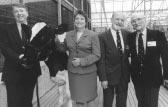
Interesting “material” facts:
➤ 111,600 square feet of 6mm thick semi-transparent polyethylene plastic were installed.
➤ 5,580 square feet of solar block netting and 22,000 square feet of weather block netting were installed.
➤ Six miles of structural piping was used to construct the barn.
➤ 130 truckloads of concrete were needed.

➤ It takes 16,000 gallons of recycled water to flush the building.
➤ The manure holding facility has a capacity of 10,000 cubic yards.
➤ The area under plastic is 29,600 square feet, the area of the building under roof is 5,460 square feet.
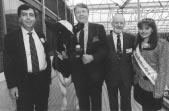
4
(continued
Pennsylvania Secretary of Agriculture Charles Brosius addresses the guests, Dean Kelly and University President Judith Rodin in the background.
Mr. Richard G. Wood, Wawa, Inc., Dean Kelly, Dr.Marshak, Angela M. Werley, Pennsylvania Dairy Princess.
Dr. Kelly, Mrs. Barbara Hafer, State Treasurer, Dr. Marshak and Dr. Allam
The Josephine Deubler Genetic Disease Testing Laboratory
Dean Alan M. Kelly announced at the Canine Symposium that the School is establishing the Josephine Deubler Genetic Disease Testing Laboratory. The laboratory is part of a service that will encompass a genetic testing and counseling program in the School’s Section of Medical Genetics. It is named after the School’s first female graduate, Dr. Josephine Deubler, V’38, who served on the faculty until 1987 and is still active in School affairs. Dr. Deubler is a liaison between the School’s veterinary researchers and clinicians and breeders and pet owners. She also is the force behind the annual canine and feline symposia for breeders and owners of dogs and cats.
Hereditary diseases of companion animals are an important problem for breeders and owners. More than 350 inherited disorders have been identified in the dog and over 150 in the cat. As research continues, many more will come to light. To reduce the spread of such disorders in purebred dog and cat populations, breeding animals need to be tested to identify
affected, carrier and healthy animals. The School’s Section of Medical Genetics is a pioneer in identifying genetic diseases in companion animals, determining the modes of inheritance, and developing tests to identify affected, carrier and healthy animals.
The Josephine Deubler Genetic Disease Testing Laboratory will be based upon the research and development in veterinary medical genetics here at the School. Molecular genetic, biochemical and hematologic methods will be used to identify affected and carrier animals. Several genetic tests are now available for hereditary blood and metabolic diseases and blood typing. The genetic testing laboratory is enhanced by a weekly Pediatrics and Genetics Clinic at the Veterinary Hospital of the University of Pennsylvania (VHUP) and the Canine Genetic Disease Information System (to be expanded to cats) to provide counseling and advice on the management of affected animals and on breeding companion animals free of genetic dis-
ease. The program will also allow for the investigation of the prevalence of certain genetic diseases and will aid in the identification of new hereditary diseases.
The Genetic Testing and Counseling Program will become a reliable resource at an affordable rate. It will be a nonprofit operation under the auspices of the University of Pennsylvania School of Veterinary Medicine, supported by donations and modest service fees.
The Josephine Deubler Genetic Disease Testing Laboratory will be operational by early summer.
Support for the Josephine Deubler Genetic Disease Testing Laboratory and the Genetic Testing and Counseling Program has been received from Pedigree® and a number of individual donors. The School is currently engaged in raising the funds to fully support this project that will benefit breeders and owners of companion animals. For further information, please contact the School’s Development Office at 215-898-1480.
An Evening in Old Saratoga Correction
In Bellwether 38 we reported that a bequest to support equine endowment had been received from the estate of G. Violet Hayes. This was in error as the last name was mispelled. The bequest was received from the estate of G. Violet Haines.
G. Violet Haines was a long-time Welsh pony breeder and managed a riding school and summer day camp in Gwynnedd Valley, PA. She taught generations of children to ride and to enjoy horses, especially her beloved Welsh ponies. She was one of the first Welsh pony breeders to breed her many stallions to Thoroughbred mares to produce show ponies. She was the Pennsylvania Horsebreeder Association’s Horsewoman of the Year in 1986. Ms. Haines used the services of New Bolton Center and when she died, at the age of 89, in December of 1992, she left part of her estate to the School. This money will be used to support endowment for equine sports medicine and research in physiology. Her bequest creates a lasting way to reflect her devotion to horses and to Welsh ponies in particular.
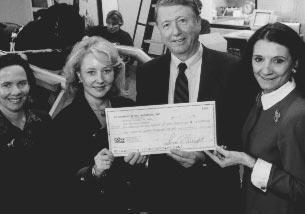
5
The Gala benefit for New Bolton Center, hosted by the An Evening in Old Saratoga on August 5, 1996, raised $80,430. Shown here are Mrs. Lawrence E. Ensor, Jr. and Mrs. John R. Landan as they present the check to Dr. Virginia B. Reef and Dean Alan M. Kelly on behalf of the Gala Committee. Dr. Reef is having the first transesophageal probe developed in Norway. This instrument will be used for diagnostic purposes in conjunction with the color flow Doppler ultrasound machine acquired with the funds raised by the 1995 Gala. An Evening in Old Saratoga will again host a benefit for New Bolton Center on Saturday, August 2, 1997.
Parasitology Research at the School
Animal health is closely tethered to the health of the general populace. With mankind’s heavy reliance on animals for social support and nutritional sustenance, our well-being, in many ways, mirrors that of the various species occupying our realm. In no way, perhaps, is this more apparent than in the field of parasitology.
Global leaders in the study of parasitic diseases, researchers at the School’s Laboratory of Parasitology — part of the Department of Pathobiology — combine their diverse academic interests to broaden our understanding of vectortransmitted diseases that impact public health. Funded largely by leading research institutions, including the National Institutes of Health (NIH), World Health Organization (WHO), Burroughs Wellcome Foundation and Merck Foundation, their investigations contribute to the development of treatments and prevention strategies — in animals and people — that are viable in both developed and third-world countries.
Dr. Gerhard A. Schad, professor of parasitology at the School, studies nematode growth and development. The primary focus of his research is on Strongyloides stercoralis, a gastrointestinal helminth particularly destructive in immunocompromised individuals. In the U.S., S. stercoralis is a significant public health concern in southern Appalachian communities, as well as in institutions, where personal hygiene is often inadequate. It also infects people in poorlysanitated foci of tropical and subtropical regions, such as Brazil, the Caribbean islands and southeast Asia. S. stercoralis larvae penetrate the intact skin of humans who come in contact with fecallycontaminated soil. Three outcomes of S. stercoralis infection are possible. One may become a silent carrier and show no clinical signs; in the most common scenario, he or she may develop acute strongyloidiasis, characterized by enteritis and weight loss; in hyperinfection, seen in immunosuppressed individuals, larvae migrate throughout the body, causing tissue destruction and possible death.
“We’re trying to understand the developmental biology of strongyloidiasis that
results in hyperinfection, disseminated infection and chronic infection,” says Dr. Schad. “This would provide a basis for better control of the disease.”
Dr. Schad’s lab, one of the few worldwide that investigates S. stercoralis infection, performs laser microbeam ablation studies to identify the neurons in the worm’s anterior sense organs that are involved in the infection process. This could facilitate an understanding of the signals that reactivate development of infective larvae upon entry into a host, and lead to new approaches in parasite con-
induce allergic responses, including filarial fever, joint inflammation and tropical pulmonary eosinophilia, which is characterized by lung infiltrates that cause paroxysmal coughing.
O. volvulus, which is transmitted by black flies, is implicated in “river blindness” in South and Central America, and Africa. In infected humans, adult worms reside in subcutaneous nodules, causing dermatitis. Microfilaria migrate through the skin and eventually invade the eye, damaging the cornea, retina and optic nerve. Large parasite burdens can, with chronicity, cause permanent blindness.
Because of the “long-term consequences of being incapacitated in underdeveloped economies,” says Dr. Lok, the study of filariasis — “a disease of the poorest of the poor,” is crucial to improving public health in third-world countries.
trol. Working closely with Dr. Schad, Dr. Thomas Nolan, adjunct associate professor of parasitology, is studying S.stercoralis autoinfection. In autoinfection, larvae develop into egg-laying adults within the host, which is then reinfected by the larvae which hatch within the intestine. Autoinfection occurs most frequently in immunosuppressed patients. Using a gerbil model, Dr. Nolan is working to determine the impact of immunosuppression and certain physiologic factors, such as gut motility, on the development of autoinfection in strongyloidiasis.
Like S. stercoralis, several filarial nematodes cause severe systemic disease in humans. Dr. James Lok, associate professor of parasitology, is studying two filariid parasites, Brugia malayi and Onchocerca volvulus B. malayi , which is transmitted by mosquitoes, afflicts some 100 million people worldwide, primarily in southeastern and northern Asia. Adult worms invade the lymph nodes and lymphatic vessels, causing obstructive disease (the end stage of chronic lymphatic filariasis is elephantiasis, a disfiguring condition). Resulting microfilaremia can
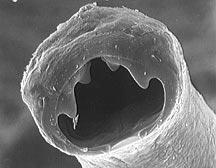
In the lab, Dr. Lok is using gerbil models to study the developmental biology of the larvae, which arrest in the vector at the infective stage and resume development upon transmission to a mammalian host.
“One of the reasons there are so few satisfactory drugs to prevent filarial infections in humans is that we don’t yet know what causes these larvae to resume development once they are transmitted,” Dr. Lok explains.
Parasitic mechanisms are not sole determinants of virulence. Just as important are immune responses elicited in hosts. Drs. Jay Farrell and Phillip Scott study host immune responses to Leishmania, the intracellular protozoan parasite that causes leishmaniasis. One of six major diseases on which WHO is focusing its efforts, leishmaniasis afflicts over ten million people globally, primarily in northern Africa, southern Europe, India, Pakistan and South America.
Leishmania is transmitted between humans and its primary reservoir hosts, dogs and rodents, by sandflies. Infection generally takes one of two courses: a cutaneous form, in which localized skin lesions develop, and a visceral form, in which infection metastasizes to the liver, spleen and bone marrow. Visceral leishmaniasis carries a 90 percent mortality
6
Parasitology Research at the School (continued)
rate. Cutaneous leishmaniasis, however, may resolve over several months. The primary determinant of this outcome rests within the host.
“In humans, non-healing infections are characterized by the production of high amounts of antibody and little cellmediated response,” says Dr. Farrell, professor of parasitology, who has been studying the disease for 25 years.
T lymphocytes, which are required for both humoral and cell-mediated immune responses, are composed of two distinct subsets — T helper 1 (TH1) and T helper 2 (TH2) cells. TH1 cells stimulate the cell-mediated immune response, which is associated with healing cases of leishmaniasis; TH2 cells potentiate humoral immunity, which is typically exhibited in non-healing infections.
Working with mice infected with Leishmania, Dr. Farrell, who heads the School’s Laboratory of Parasitology, manipulates in-vivo levels of cytokines that control T lymphocyte differentiation. This research, he says, could lead to the development of effective human drug treatment protocols that integrate immunomodulatory agents with conventional drug therapies.
Dr. Scott, who is a member of WHO’s steering committee on the development of a Leishmania vaccine, is designing
vaccines that incorporate cytokine adjuvants that preferentially induce TH1 cell production and, thereby, cell-mediated immunity. This experimentation will have far-reaching effects, he predicts.
“What we learn from our studies of Leishmania may be applicable to other chronic diseases in which inappropriate immune responses can lead to severe disease.” says Dr. Scott, professor of microbiology and immunology, who cites leprosy, tuberculosis, AIDS and cancer as a few such examples.
Also exploring immune response to disease is Dr. Chris Hunter, assistant professor in the Department of Pathobiology. An opportunistic infection in immunosuppressed patients, toxoplasmosis is caused by a ubiquitous parasite, Toxoplasma gondii. Dr. Hunter, who recently received a Burroughs Wellcome Young Investigator Award, uses immune-deficient strains of mice to study the immune response to Toxoplasma. This work has important public health implications.
“We’re now at the stage at which we can start to rationally design and formulate new vaccine and treatment strategies,” says Dr. Hunter, who has been studying Toxoplasma for nearly a decade.
Also key to the development of parasite control strategies is the construction of computer programs that quantify para-
site transmission, therapy and prevention data. Dr. Gary Smith, professor of epidemiology and population biology and director of the School’s Center for Infectious Disease and Food Safety, is developing mathematical models for ruminant parasites, including Fasciola hepatica, Haematobia irritans and several trichostrongylid nematodes; Ichthyophthirius multifiliis, a protozoan parasite that afflicts farmed fish; and Ixodes scapularis, the tick that transmits the spirochete that causes Lyme disease in dogs and humans.
“The goal in each case is to construct a computer model of transmission dynamics,” says Dr. Smith, who developed similar software for gastrointestinal nematodes of cattle, now marketed by Merck AgVet.
The software will help educate the public about parasite transmission, and lay a foundation for comparing existing control strategies and inventing new ones. Dr. Smith says the School’s dedication to parasite research plays a key role in enhancing the quality of human life.
“The majority of these infections have a worldwide distribution and threaten human health directly, as in the case of Lyme disease, or indirectly, through their effects on the supply of protein for human consumption.” — Joan
Capuzzi
The Brandywine Polo Club hosted a benefit for New Bolton Center on September 8 at the Brandywine Polo Club grounds. The club played the British Military Polo Team. It was a beautiful, exciting afternoon. Unfortunately, the home team lost. One of its star players was Dr. Cindy Mason, V’96, whose mother, Mrs. Peggy Mason, was instrumental in organizing the event.
The funds raised were for the renovation of the farrier’s laboratory. Shown here are Dr. and Mrs. Kelly and the British team.

7
Aquavet ® Celebrates 20th Anniversary
Aquavet®, conceived in 1976 by a group of faculty members from Penn’s School of Veterinary Medicine, celebrated its 20th anniversary with a scientific conference and an alumni reunion November 14 to 17 at Woods Hole.
Of 602 Aquavet alumni more than 80 attended. There were presentations of posters and papers and plenty of time to rediscover Woods Hole, tour the facilities and look at the new quarters of the Laboratory of Aquatic Animal Medicine and Pathology.
Saturday evening featured the traditional Aquavet Clam Bake/Lobster Boil and keynote speaker Dr. Richard M. Linnehan who talked about Veterinary Medicine and the United States Space Program.
Dr. Linnehan, an alumnus of Aquavet I’83 and Aquavet II’90 is the first veterinarian to be a member of the United States Astronaut Corps. He was aboard the Columbia during the longest space shuttle flight, June 20 to July 7. He conducted experiments and served as a human test subject for the life sciences and microgravity investigations. He also carried aboard a specially created Aquavet 20th Anniversary flag which was displayed at the conference and now hangs in a place of honor at Woods Hole.
In 1976 a few faculty members at Penn’s School of Veterinary Medicine were concerned that the veterinary profession did not address aquatic animal health. Discussions about an aquatic veterinary medicine program were held with the scientific community at Woods Hole and the concept received encouragement. In short order, Cornell’s College of Veterinary Medicine was approached about a joint program at Woods Hole. A New York Sea Grant Institute grant supported the effort and the first 16 students from Cornell and Penn attended Aquavet in May of 1977. The rest is history.
Woods Hole is the ideal place for such a program. Here a number of institutions are devoted to marine science education and research. It is the home of the Marine Biological Laboratory, the Woods Hole Oceanographic Institution and the Northeast Fisheries Science Center of the National Marine Fisheries Service, all
major players in the success of the collaborative Aquavet program. Each May students from all over the United States and some foreign countries come here for an intensive learning experience. Admission to the four-week program is
Attendees for this course come not only from veterinary schools but also from government agencies and private industry.
Aquavet’s many graduates today hold positions in other academic institutions, they work in governmental agencies and private foundations, have leadership roles in the aquaculture industry, and initiate the training of the next generation of aquatic animal veterinarians. A number return as teachers each May to Woods Hole.
The Aquavet program is under the direction of Dr. Donald Abt and the associate directors are Dr. Paul R. Bowser of Cornell and Dr. Laurie Landeau, a Penn and Aquavet alumnae. Dr. Abt is also the director of the Laboratory of Aquatic Animal Medicine and Pathology, a diagnostic facility that serves the Woods Hole complex and the fishery industry. This active laboratory conducts research and is the School’s third campus.
competitive. About 40 faculty members, specialists in many aspects of aquatic animal medicine, participate. The program has grown to become recognized as the bench mark veterinary academic program in aquatic animal medicine.

Aquavet I is an introductory course for veterinary students who have completed the basic science portion of their course work. Aquatic animal medicine is comparative medicine and students are challenged to transfer their training developed on dogs or horses to aquatic animals. There are lectures, laboratory sessions, field trips and research projects. It is a very intensive training period. Some students may continue during the summer to work as research fellows, either at Woods Hole or at another location. However, funding constraints have reduced the number of these positions.
While Aquavet I is the basic course, Aquavet II, established in 1983, seeks to develop expertise in the diseases of aquatic species commonly encountered as laboratory research animals or in the commercial aquaculture industry.
The Pennsylvania Veterinary Medical Historical Society Request
Do you have pictures of the area surrounding the Veterinary School? Pictures that you may have taken while at the School? We are looking for pictures taken prior to 1960. The Historical Society is interested in making a collage of these showing what the surrounding community was like in the days of the old Veterinary Quadrangle (also known as “fecal field”). Remember Jack’s Bookstore? Perhaps you may have pictures of it.
Please look through your scrap books and mail those old pictures to the P.V.M.H.S., Dr. Dan Bleicher, 1562 Marian Road, Abington, PA 19001 or P.V.M.H.S., Dr. Jack Bregman, RD#1, Delhi, NY 13753.
8
New Hope Now forBowed Tendons
by Virginia B. Reef, D.V.M.
Ultrasonography is a well-established, valuable tool for diagnosing the type and severity of tendon and ligament injuries in horses.
Its use as part of a rehabilitation program can help the veterinarian, trainer and owner successfully return the horse to competition, minimizing the chances of the horse’s returning successfully to its previous level of competition.
Beta-aminoproprionitrile (BAPN) is a scar-remodeled drug which has been shown to improve the quality of tendon and ligament repair in horses.
BAPN is found in seeds of the wild sweet pea, Lathyrus odoratus. BAPN, administered in the early stages of scar formation, blocks the enzyme lysyl oxidase and thus blocks the formation of collagen cross-links in the area of injury. This brief interruption of collagen crosslinking allows for physiologically beneficial scar remodeling to occur.
Clinical trials using betaaminoproprionitrile fumarate (BAPN-F) in horses with acute bowed tendons have demonstrated improved tendon healing. Carefully designed double-blind placebo controlled trials showed the efficacy of this treatment. These studies are an important new application of ultrasonography and should help veterinary medicine make significant advances in the treatment of tendon and ligament injuries in horses.
Double-blind placebo controlled trials have not previously been performed to evaluate the efficacy of other treatments for tendon and ligament injuries.
More than 200 horses with a recent injury (one to three months) to the superficial digital flexor tendon have been treated with intralesional BAPN-F (Alcoa Inc., Tucson, AZ) following the tendon injury, primarily at the University of Pennsylvania School of Veterinary Medicine at New Bolton Center in Kennett Square, PA by my coworkers and me, and at Randall Veterinary Hospital in Warrensville Heights, OH, by Dr. Ron Genovese and his coworkers. This drug has also been administered to horses with other tendon and ligament injuries.
All horses were racing, training or involved in other types of equestrian competition at the time the injury occurred. The majority of treated horses were racehorses.
The treated horses had large areas of damage to the superficial digital flexor tendon. Affected tendons were at least 50% larger than normal or the crosssectional area of the affected tendon was at least 1.5cm. The lesion involved at least 25% of the tendon’s cross-sectional area at its worst and extended over at least three of seven zones.
Following a sterile prep, BAPN-F was injected throughout the injured area with a 27- gauge needle every other day for a total of five treatments.
Horses were then placed in a rigorous low-level controlled exercise program with frequent ultrasound monitoring. The treated horses began walking 30 minutes per day for four weeks, which then increased to 45 minutes daily for another four weeks. All subsequent increases in the horse’s exercise were based upon improvement in the ultrasound (sonographic) findings.
If sonographic improvement was detected eight weeks following treatment, a small amount of jogging (no more than five minutes per day at a five to six minute per mile pace) or swimming exercise was added to the exercise program. This was increased to 10 minutes per day if sonographic improvement was detected at 12 weeks.
If continued sonographic improvement occurred at 16 weeks, then turnout in a small paddock was permitted. The amount of jogging exercise remained stable or continued to increase by five minutes per month until 24 weeks.
If continued sonographic improvement occurred at 24 weeks, the horses started galloping. The first start occurred no sooner than 40 weeks following treatment and was longer in horses with more severe injuries.
Follow-up ultrasound examinations revealed a better quality of tendon repair in the BAPN-F treated horses, when compared to placebo controls.
Tendon cross-sectional area was significantly decreased, and fiber alignment was improved significantly at 16 weeks in horses treated with the seven or eightmg doses of BAPN-F. These findings persisted as the horse went on into more rigorous training.
Any increase in tendon cross-sectional area (thickening) between examinations resulted in the horse remaining at the same exercise level for an additional four weeks, unless the increase in tendon cross-sectional area was greater than or equal to 25%, in which case the amount of trotting exercise was decreased or discontinued altogether for the subsequent four weeks.
Increases in tendon cross-sectional area of this magnitude indicated excessive tendon loading for the stage tendon healing and increased the risk for reinjury.
A gradually increasing controlled exercise program should be a routine part of the rehabilitation of horses with tendon and ligament injuries.
Periodic ultrasound examinations should be performed prior to each increase in the horse’s exercise level to be sure that the horse is ready to advance to the next exercise level.
Long-term follow-up data is still being obtained on these horses to evaluate their return to performance. But initial studies indicate a significantly high percentage of BAPN-F treated horses are able to return successfully to competition without recurrence of the injury, the ultimate goal of the treatment of equine athletes with tendon injuries.
9
Commencement
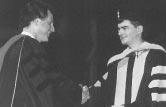
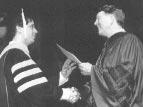
The Zellerbach Theater at the Annenberg School was again the site of the Schools’ Special Commencement Exercises for the Class of 1996. The School’s graduates now number 5,209 with the most recent class of 77 women and 27 men.




Families and friends crowded into the auditorium to cheer “their” graduate. The Commencement address was delivered
by Marty Fettman, D.V.M., Ph.D., Professor of Pathology, Mark L. Morris Chair in Clinical Nutrition at the College of Veterinary Medicine and Biomedical Sciences, Colorado State University. Dr.Fettman was the first veterinarian to fly in space. He was aboard the space flight on October 18, 1993 as a payload specialist.
Class of 1996
Sharman Buechner Altshuler***
Reynell Andrews
Kimberly Bailey-Glenn
Abigail Elizabeth Banzhof
Tracy Anne Barlup
Isolde Ann Baylor-Aguirre
David Edward Bentzel, Jr.
Mari Sue Berens
Melissa Joann Berg
Marcella Bernstein
Marian Crescentia Boden
Jeffrey Allen Booth
Ylva Susan Helena Bostrom
Kimberly A. Bowers
Jennifer Ann Bucci
Karen Victoria Bullock
Jennifer Marie Card
Jessica McNeil Caverly**
Katherine Begg Chope
Janice Irene Chu
Ilan Gil Cohen***
Jessica Simboli Collins
Michelle Ann Collins
Milissa Renee Cooper
Kelly Anne Craig
Tyra Louise Crowley
Susan Patricia deLeon
Beth Anne Derr
Brett Allison Dolente
Leonard Nunzio Donato
Daryl Lynn Drnevich
Charles Samuel Dunn
Aimee Lara Edinger*
Joshua Jon Erde
Joseph Inge Ewaskiewicz*
Marnie Colleen FitzMaurice**
Alexandra Coleman Floyd
Donald Force
Hilary Hosmer Fordyce
Karen Mary Froberg-Sleph***
Reina Norie Fuji*
José Miguel García-Lopéz
Caroline Katherine Garzotto**
Brett Jason Geffen
Kelly Anne Georgeou
Sharon Diane Gottfried
Julianne Elizabeth Grady
Donna Marie Greybek
Suzanne Lynne Groskoph
Jeffrey Allen Gross
Susan Marie Gula
Sander Oscar Hacker
Guy Robert Hammond
Janet Nancy Hanning
Valerie G. Heartsfield
Heather Michelle Hendler
Sasha Hilchuck
Sallie Sarah Hyman
Bridgette Senta Jablonsky
Leonard Ari Jutkowitz
Susan Diane Katila
Kimberley Jane Khodakha
Rebecca Ann King
Brenda Arlene Klaunberg
Debra Susan Kriftcher
Linda Christina Kutrubes
Marianne Nardi Linton
Fiona Morag Little**
Sarah Lynn Logan
Christine Helga Lundy
Jill Ann Luscombe
Susan Madigan
Patricia Jeanne Mapps
Jacqueline Amanda Martin**
Cynthia Jo Mason
Geri Beth Mayer
Robert Clifford McLear***
Elizabeth Ann Ritchey Morgan
Margaret M. Mullin
Donna Frances O’Leary
John Joseph O’Mahony
Tracy Ann O’Malley
Beth E. Philipson
Christian Andrew Pinney
Bradley Stuart Pondish
Catherine Ann Racek
Charles Thomas Reid
Nancy Jeanne Resciniti
John P. Ruffing
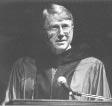
Thomas Peter Schär
Jennifer Lori Schickler
Adam Christopher Schure
Ruth Ellen Shedwick**
Bruce Eliot Silverman

Laurie Ann Sponza***
Robert Thomas Sullivan, Jr.
Melanie Jean Sumney
Karen Tabak
Barbara Anne Tallant
Christine Lynn Tranchida
Catherine Frederika Trumble
Karen Lynne Usselman
Paul Joseph Wagner
Michael Hertzog Yarnall
*** Summa Cum Laude
** Magna Cum Laude
* Cum Laude
10
Award Recipients
Leonard Pearson Prize
Reina Norie Fuji
J.B. Lippincott Prize
Sharman Buechner Altshuler
1930 Class Prize in Surgery
Marnie Colleen FitzMaurice
Auxiliary to the American Veterinary Medical Association Prize
Karen Mary Froberg-Sleph
Auxiliary to the Pennsylvania Veterinary Medical Association
Prize - Small Animal Award
Daryl Lynn Drnevich
Auxiliary to the Pennsylvania Veterinary Medical Association
Prize-Large Animal Award
Brett Allison Dolente
1956 Class Medal for Achievement in Pathology
Sharman Buechner Altshuler
James Hazlitt Jones Prize in Biochemistry

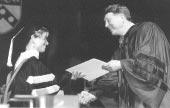
Aimee Lara Edinger
American Animal Hospital Association Award
Charles Samuel Dunn
Merck Small Animal Award
Sharman Buechner Altshuler
Merck Large Animal Award
Katherine Begg Chope
George M. Palmer Prize
Sallie Sarah Hyman
Everingham Prize for Cardiology

Sharman Buechner Altshuler
Large Animal Surgery Prize
Thomas Peter Schär
Large Animal Medicine Prize
Joseph Inge Ewaskiewicz
Morris L. Ziskind Prize in Food Animal Medicine
Melanie Jean Sumney
Morris L. Ziskind Prize in Public Health

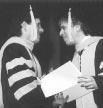

Reina Norie Fuji
Hill’s Award
Sharon Diane Gottfried
Upjohn Small Animal Award
Susan Madigan
Upjohn Large Animal Award
Jennifer Marie Card
Faculty/SCAVMA Prize
Robert Clifford McLear
Field Service Award
Milissa Renee Cooper
American College of Veterinary Surgeons Prizes
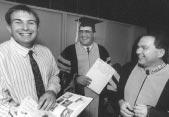
Small Animal Surgery Prize
Caroline Katherine Garzotto
Large Animal Prize
José Miguel García-Lopéz
American Association of FelinePractitionersAward
Laurie Ann Sponza
Phi Zeta Award
Ilan Gil Cohen
Anatomy Prize
Marnie Colleen FitzMaurice
American College of Veterinary Radiology Award

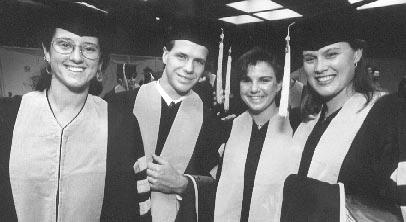
Donna Marie Greybek

11
Alumni Notes
Alumni Day 1996
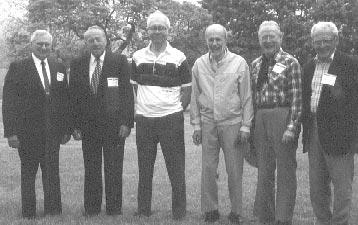
Held on a warm and beautiful May 17, 1996, the School of Veterinary Medicine’s Alumni Day 1996 drew a crowd of over 300 alumni, family and friends to New Bolton Center. The day began with a continental breakfast with Dean Alan M. Kelly and was followed by a meeting of the General Alumni Society. Alumni Awards of Merit were presented to Wilbur Amand, V’66, Jack Bregman, V’66, and Harriet Doolittle, V’61. Afterwards there was an afternoon of food and fun with a picnic barbecue lunch, dancing and special entertainment for children. Additionally Dr. Martin Fettman, D.V.M., the first veterinarian in space spoke to a full house about his travels.
Alumni Day 1997 begins with the Dean’s Cocktail Reception on the evening of Saturday, May 17 and continues on Sunday, May 18 with the Alumni Barbeque Picnic. All events will be held at New Bolton Center. Look for more information in your upcoming Class Agent letters. Alumni from all years are welcome!
President’s Message
Every September a new class enters veterinary school and the Alumni Society gets a new President. I graduated in 1984 when tuition was only $8,000 per year. This year’s class will face a tuition bill of almost $22,000 per year. The fact that the School receives so many applications reflects on the quality of the education that is provided. As alumni, we can mitigate the issue of high tuition through contributions to the Veterinary Annual Giving Fund.
In January ’96, the Executive Board of the Veterinary Medical Alumni Society voted to utilize the entire proceeds of the Alumni Annual Giving 1995-96 for student scholarships, unless otherwise designated by the donor. For the current school year over 120 students, including the entire senior class, received financial assistance from this fund.

On behalf of the Executive Board, I wish to thank the donors to Alumni Annual
Giving 1995-96. Below are a few of the letters received by the Board from scholarship recipients. It is my hope for the 1996-97 campaign that donor generosity will allow the Alumni Society to financially assist an even larger percentage of the student body. I look forward to meeting many of you on Alumni Day, Sunday May 18, 1997 at New Bolton Center.
Carol Swandby, V’84 President
Veterinary Medical Alumni Society
Dear Dr. Swandby,
Thank you very much and thanks to all those alumni who have given to the Annual Giving Fund, which has made these scholarships possible. I know that when I am an alumnus I will enjoy seeing my contributions used in this way.
Sincerely, John Lewis,
V’97
Dear Dr. Swandby,
I wanted to write and thank you and the entire Veterinary Medical Alumni Society for your generous contribution(s) towards student financial aid. Every bit of support makes a difference to help defeat the huge cost of attending veterinary school.
Four years ago, when I was considering whether or not to make the financial commitment to go to veterinary school, I realized that there was nothing else in the world that I wanted to do with my life more than be a vet. Regardless of the cost, I decided to make the plunge. The past three years have been strenuous but rewarding. I am really excited for each day of continued learning, and for my future in this profession.
I hope the alumni are able to continue to contribute, and through this giving, tuition may some day be more affordable. I am sure there are some great students out there who would make terrific vets, but due to the high cost, choose to pursue something else. Thanks again.
Sincerely,
Bonnie Shope, V’97
12
Class of 1966
Class of 1946
Benjamin Franklin Society Dinner
On the evening of Friday, September 27, 60 members of School community attended a dinner in honor of veterinary alumni and friends who are members of the Benjamin Franklin Society. Held at the Brandywine River Museum in Chadds Ford, PA the evening started with a cocktail reception followed by dinner in the museum’s restaurant overlooking the Brandywine River. Dean Alan M. Kelly briefly spoke about current issues and activities at the School, noting that over 120 students are benefitting this year from Veterinary Alumni Annual Giving whose proceeds are used solely for student scholarship. Membership in the Benjamin Franklin Society reflects unrestricted gifts to the School of $1,000 and above.
Members of The School of Veterinary Medicine’s 1995-96 Benjamin Franklin Society are:
Donald A. Abt, V.M.D.
Edwin J. Andrews, V.M.D.
Alan Bachrach, Jr., V.M.D.
Jarvis J. Badgley, V.M.D.
Harry F. B. Bartolett, V.M.D.
Charles N. Bell, V.M.D.
Darryl Biery, D.V.M.
Daniel D. Bleicher, V.M.D.
Elizabeth Boden, V.M.D.
Rodney Boden, V.M.D.
Kenneth L. Bollens, Jr., V.M.D.
Malcolm Borthwick, Jr., V.M.D.
Martin A. Bree, V.M.D.
Jack Bregman, V.M.D.
Joseph G. Brewer, V.M.D.
David R. Burnett, V.M.D.
Earl W. Cook, V.M.D.
Mr. William Polk Carey, W’53
D. Thomas Derstine, V.M.D.
David K. Detweiler, V.M.D.
M. Josephine Deubler, V.M.D.
Larry A. Dieter, V.M.D.
Alonzo Edmiston, Jr., V.M.D.
Russell S. Edmonds, V.M.D.
Sheldon S. Farber, V.M.D.
Joseph D. Fecher, Jr., V.M.D.
Paul Fenster, V.M.D.
Fred Fernich, V.M.D.
Lorraine A. Fournier, V.M.D.
Stuart A. Fox, V.M.D.
Jerry D. Frantz, V.M.D.
Ross L. Frazer, V.M.D.
L. Thomas Gemmill, Jr., V.M.D.
Lillian A. Giuliani, V.M.D.
Melvyn D. Hale, V.M.D.
William D. Hardy, Jr., V.M.D.
James S. Harper, III, V.M.D.
G. L. Hartenstein, III, V.M.D.
George L. Hartenstein, IV, V.M.D.
Park W. Haverstick, V.M.D.
Peter H. Herman, V.M.D.
Max J. Herman, V.M.D.
Carla Hernas, V.M.D.
D. Ray Hostetter, V.M.D.
Elsie Sterling Howard, CW’68
Howard C. Hughes, Jr., V.M.D.
Charlotte Miller Keenan, V.M.D.
Charles W. Koenig, V.M.D.
Elmer F. Laffey, V.M.D.
Laurie J. Landeau, V.M.D.
J. Harold Landis, V.M.D.
Midge Leitch, V.M.D.
Dr. Anna Harris Live ,
In honor of Israel Live, V.M.D.
Walter F. Loeb, V.M.D.
Victor M. Longoria, V.M.D.
M. Phyllis Lose, V.M.D.
Ann Wayne Lucas, V.M.D.
Leigh A. Marsh, V.M.D.
Robert F. Martin, V.M.D.
William H. McCormick, V.M.D.
John D. McCullough, V.M.D.
Norbert R. McManus, V.M.D.
Jonathan E. Meincke, V.M.D.
David A. Meirs II, V.M.D.
Edward Mersky, V.M.D.
Maurice F. Metcalfe, V.M.D.
Edward M. Mimnagh, V.M.D.
James F. Mock, V.M.D.
Calvin Moon, V.M.D.
Mary E. Moon, V.M.D.
Roger A. Murphy, V.M.D.
Sherbyn W. Ostrich, V.M.D.
Juan L. Ferrer Perez, V.M.D.
David M. Petrick, V.M.D.
Paul W. Pratt, V.M.D.
Edward C. Preston, V.M.D.
Michael P. Ratner, V.M.D.
Carolyn Reed, V.M.D.
Gail D. Reidler, V.M.D.
Sydney Rosenberg, V.M.D.
Dan Rosenberg, V.M.D.
Ellis F. Rubin, V.M.D.
Kenneth J. Rubin, V.M.D.
Frederick R. Rude, V.M.D.
Harold E. Schaden, V.M.D.
Linda M. Schoenberg, V.M.D.
Robert R. Shomer, V.M.D.
Donald A. Skinner, V.M.D.
Russell J. Snyder, V.M.D.
Robert W. Stewart, V.M.D.
Kenton S. Stokes, V.M.D.
Amos W. Stults, V.M.D.
Amos W. Stults, Jr., V.M.D.
Stephen W. Syken, V.M.D.
E. B. Thorndike, Jr., V.M.D.
Robert L. Ticehurst, V.M.D.
George D. Vernimb, V.M.D.
Lynn Mirbach Walker, V.M.D.
Melvyn G. Wenger, V.M.D.
Raymond J. Widmann, V.M.D.
Clifford F. Wright, Jr., V.M.D.
Geoffrey H. Wright, V.M.D.
Charles G. Ziegler, V.M.D.
George F. Zimmerman, V.M.D.
Dear Dr. Swandby,
I am writing to thank you and the entire Veterinary Medical Alumni Society for the generous scholarship from the Alumni Annual Giving Fund. ... This action, along with all of the positive work accomplished by the veterinary school’s faculty and staff in the past, once again displays the School’s efforts in reducing the financial burden placed on its students.
While I will continue to strive for excellence in my academic endeavors for my own self-gratification, opportunities for scholarships will certainly be motivational. In addition, I will offer my assistance in raising future alumni donations in order to help make more money available to my peers. I hope one day to be sufficiently stable financially in order to donate money to the Alumni Fund. I would be pleased to give a future veterinary student the same sense of accomplishment and gratification that you have given me.
Sincerely,
Chick Weisse, V’98
Dear Dr. Swandby,
I would like to personally thank the Veterinary Medical Alumni Society for their generosity to the student body. Often students feel far removed from alumni because of hectic schedules and too few inclusive activities, but this $1,000 scholarship to every member of our senior class will help to bridge the gap between graduating student to active alumnus/a. The time and effort expended to decrease our financial burden will not be forgotten. I hope to someday contribute greatly, with whatever means or capacity I can, to enrich our evolving veterinary education endeavors at the University of Pennsylvania School of Veterinary Medicine. Thanks again for recognizing our financial needs and helping to ease some of our loans.
Sincerely,
Ernest “Scott” Weber, V’97
Dear Dr. Swandby,
I would like to extend my warmest thanks for the generous $1,000 scholarship I recently received from the Alumni Annual Giving Fund. It was a great honor and surprise to learn of this wonderful award which will greatly help to decrease my tuition loan burden during the last year of my veterinary education.
Dr. Newton explained that the funds for this scholarship came from gifts contributed by 1,200 alumni representing every graudating class from 1995 back to 1928. It makes me feel very good to be part of such a prestigious veterinary school whose alumni display great pride and concern through the generation of such an amazing gift… Thank you, and all the alumni who made this magnificent scholarship possible.
Gratefully yours,
H.
Frances Haberstroh, V’97
13
Catching Up with Penn Alumni atthe North American Veterinary Conference in Orlando
Alumni Awards

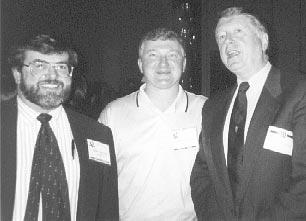
Scholarships
The School used funds from the Commonwealth to award every Pennsylvania student a $3,400 scholarship.The generosity of our alumni to the Alumni Annual Giving Fund allowed the granting of a $1,000 scholarship to every senior student.
The Naugatuck Valley Kennel Club has awarded a scholarship to Laney Jean Baris, V’00 The Montgomery County Kennel Club has awarded scholarships to both Jeffrey Berman, V’98 and David McCrork, V’98 . Educational Grants from the American Kennel Club were awarded to Christine M. Burnhans-Pool, V’99, Emily L. Elliot, V’97, Shannon D. Shank, V’99 and Ernest P. Weber III, V’97.
Mark Restey, V’99 has received a scholarship from the Bread and Roses Community Fund. The recipient of the Westminster Kennel Foundation Scholarship is Tracy Fichtl, V’97. The Somerset Hills Kennel Club Scholarship has been awarded to Ernest “Scott” Weber, V’97. Both Scott Weber, V’97 and Kerri Davis, V’98 have received scholarship grants awarded by the New Jersey Veterinary Education Foundation.
The Harriet M. Pomeroy and Fred E. Pomeroy Scholarship for Graduate Study in
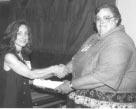

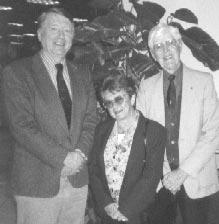
Biology was awarded to Sean Sawyer, V’00
The recipient of the Clifford F. Wright, Jr. Scholarship is Lori Perkins, V’97. Rebecca Ozimok, V’97 has been awarded the Israel and Anna Live Scholarship. Hazelyn Patterson, V’00 was awarded a grant from the Alonzo Edmiston, Jr. Book Fund. The Mallinkrodt Veterinary Scholarship was awarded to Kelly Hullihen, V’97
The William Goldman Foundation has awarded scholarships to five students: Elizabeth Bunting, V’97, Mary Jane Potter, V’97, Ernest “Scott” Weber, V’97, Bethany Grohs, V’98, and Karen Moulin, V’98.
The Pennsylvania Veterinary Foundation, in memory of Dr. Palace H. Seitz, has awarded scholarships to George A. Motley, V’98, and Donna L. Riddle, V’98 . The Dr. Samuel F. Sheidy Memorial Scholarship has been awarded to Elizabeth Bunting, V’97.
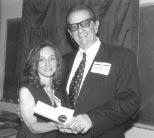
Christine Harshbarger, V’97 has been awarded the Dr. Samuel B. Guss Scholarship.
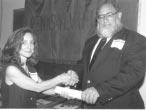
Regina M. Turner, V’89 has been granted a fellowship from the Dr. A. Wayne Mountan and Dr. Russell S. Detwiler Memorial Funds.
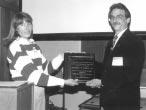
14
Dean Alan Kelly, Mrs. Alice Ticehurst, Dr. Robert Ticehurst, V’34
Dr. Gregory Bossart, V’87, and friend, Dr. Jules Silver, V’47, Mrs. Lucy Silver, Dean Kelly
Dr. John A. Marshall, V’82, Dr. Andrew Nebzydoski, V’84, Dean Kelly
Dr. Betsy Aiken, V’78, Eugenia Warnock, Director of Alumni Affairs, Dr. Patricia Whittaker, V’79, Dr.Nadine Oakley, V’78, Dr. Glen Gillard, V’80, Dr. Randy Aronson, V’80, Dean Kelly
Dr. Jack Bregman, V’66, receives the Alumni Award of Merit from Dr. Diane Eigner, V’80.
New Alumni Society President Dr. Carol Swandby, V’84, presents the President’s Award to outgoing President Dr. Stephen Syken, V’86.
Dr. Eigner presents the Alumni Award of Merit to Dr. Wilbur Amand, V’66.
Dr. Harriet Doolittle, V’61, receives the Alumni Award of Merit from Dr. Eigner.
Open House
The School’s Open House on September 21 was a huge success. About 10,000 people came to New Bolton Center to see what the School was all about!
Students, staff and faculty had worked very hard again setting up exhibits showing clinical care at NBC and at VHUP, research projects, and information about food safety and toxic plants. New this year was a M.A.S.H. tent staffed by clinicians and students to take care of repairs of stuffed animals. These patients ranged from little rabbits to a giant whale. Unlike at our two hospitals, here the owners assisted in the procedures. The youngsters were properly garbed in gowns, hats, masks and gloves and provided cheerful guidance to the surgeons.
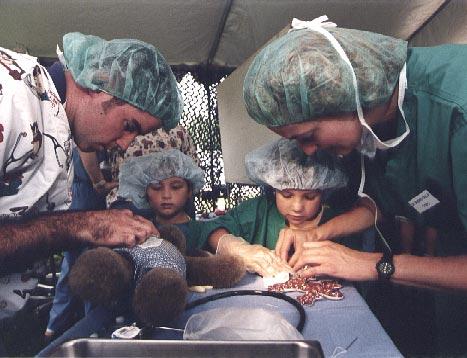
The six-horse Percheron hitch was very popular as were the Llama obstacles course, the police dog demonstration and a canine puissance.
National Championship
A canine athlete and her human handler brought a national championship to Philadelphia. FC-AFC Candlewood’s Bit O’Bunny, handled by her owner, Henry S. McNeil, Jr., garnered the ultimate crown in retriever field trialing: the 1996 National Amateur Field Trial Championship.
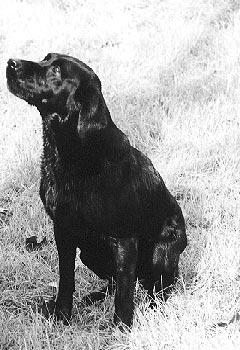
Babe, as the 5-year old black Labrador retriever is called, was the only female and one of the youngest of the ten finalists in a field of 85 as she went into the deciding series of the week-long competition in Stowe, VT in June.
“She was just brilliant,” said Hank McNeil. “She performed flawlessly throughout the difficult competition.” During the seven day trial Babe ran 10 series. The dogs had to do land and water retrieves of increasing difficulty and were judged on the precision exhibited to complete these. After each series dogs were eliminated until only ten remained, the top retrievers in the country. Babe emerged victorious to claim the sterling silver trophy.
Field trialing is team work between dog and handler. Babe and McNeil train several days a week at Winslow Farms, his land restoration project in New Jersey. He has reclaimed former quarry properties and is in the process of transforming the quarries into ponds and the more than 700 acres into grasslands.
McNeil obtained Babe at the age of 2 — from a friend in the Midwest. “Her talent was awesome, but her behavior in competition was not as impressive,” he said. “It took 18 months, two different trainers and myself before she became this dominant force. She is a smart and athletic and spectacular when she is motivated.” Babe is a Center City house dog.
On the way to the NAFC title, Babe earned 30 points in the Open Class in 16 East Coast competitions. She scored high in the ’95 Open, won a Doubleheader and was ’95 High Point Open Bitch.
Babe has passed her talent to her offspring. Three of her four living pups have already garnered more than 100
Derby points. Babe’s medical needs are met by the doctors at VHUP. She has been here for routine checks, used the Emergency Service and has had minor surgery.
15
Dr. Willi K.E. Weichelt, V’64 , was elected president of the Pennsylvania Veterinary Medical Association. The other officers of the organization elected were: Dr. Harvey Bendix, V’75 , as president-elect, Dr. Richard Detwiler, V’48 , as AVMA alternate delegate, and Dr. Charles D. Clark, V’61 , as secretary-treasurer.
Dr. James Wilson, adjunct associate professor of clinical studies, was named Veterinarian of the Year by the PVMA. At the Annual Meeting of the AVMA, Dr. Wilson received the Student AVMA Teaching Excellence Award, Clinical Sciences, in recognition of excellence, innovation, and enthusiasm in the field of basic veterinary science education.
Dr. Gail K. Smith, V’74 , professor of surgery, received an AKC Excellence in Canine Research Award at the AVMA Annual Meeting.
Dr. Frank Entwistle, V’45 , and Dr. Richard Kennedy, V’60 , received the Outstanding Public Service Award from the PVMA. Dr. Ellwood Borger, V’46, received a Special Award for providing wood-working materials that helped raise funds for the Auxiliary to the PVMA.
Scott Weber, V’97, and Dr. Abby Maxson, V’87 , spent a month in the Turkana district in north-western Kenya to monitor hydatid disease. The project was administered by the African Medical and Research Foundation (AMREF) and funded by Robert Fairchild , a member of the School’s Board of Overseers.
Dr. Ray Boston , professor of biomathematics, received a grant from the Grayson-Jockey Club Foundation to evaluate the effectiveness of a training program designed to prevent bucked shin. Dr. Stuart Meyers, assistant professor of large animal reproduction, also received a grant from the same foundation to develop tests of sperm cell function to enhance the ability to predict fertility efficiency of stallions.
Dr. Karen Overall, V’83 , is now a
diplomate of the American College of Veterinary Behaviorists. She is also one of the few specialists certified as an applied animal behaviorist by the Animal Behavior Society. Dr. Overall presented a series of short courses at the British Small Animal Veterinary Association meeting in September. She also received a grant from Ciba to study animal models of anxiety disorders.
Dr. Sherbyn Ostrich, V’63, has been appointed executive director of the Pennsylvania Animal Health Commission.
Dr. William J. Solomon, V’68 , has been elected president of the Pennsylvania Horse Breeders Association.
Dr. Ralph E. Werner, V’68 , was elected president of the New Jersey Board of Veterinary Medical Examiners.
Dr. Harry Rozmiarek, professor and chief of laboratory animal medicine and the University Veterinarian of the University of Pennsylvania was awarded the Charles River Prize in recognition of distinguished contributions to the field of laboratory animal medicine at the AVMA Annual Meeting. Dr. Rozmiarek was also elected president-elect of the American College of Laboratory Animal Medicine.
Dr. Paul C. Gambrella, V’72 , is one of the veterinarians featured in Animal Hospital , a book by Stephen Sawicki that chronicles one year inside Angell Memorial Hospital.
Dr. Michele Rosenbaum, V’89, lecturer in dermatology, is now a diplomate of the American College of Veterinary Dermatology. Dr. Rosenbaum presented a paper at the annual meeting of the American College of Veterinary Dermatology in Las Vegas, NV. Dr. Rosenbaum won an Allerderm Dermatology Resident Research Award, given to four residents nationally. Part of the award was a trip to Edinburgh, Scotland, where she presented her research at the World Congress of Veterinary Dermatology.
Clinicians and nurses from the School were a large group of speakers at the
Fifth International Veterinary Emergency and Critical Care Symposium in San Antonio in September, reflecting the strength of the Center for Veterinary Critical Care at VHUP. The Penn presenters were: Rosemary Biesel, AHT, Dr. Daniel Brockman, assistant professor of surgery, Jane Cohen , AHT, Allison Culp, AHT, Dr. Kenneth Drobatz, assistant professor of medicine, Dr. Joan Hendricks, V’79, associate professor of medicine, Dr. David Holt, assistant professor of surgery, Dr. Lesley King, assistant professor of medicine, Dr. Deborah Mandell, lecturer in emergency and critical care, Dr. Katherine Michel , assistant professor of nutrition, Dr. Cindy Otto, assistant professor of medicine, Dr. Sandra Perkowski, V’88, assistant professor of anesthesiology, Sally Powell, AHT, Donna Sisak, AHT, and Dr. James Wilson.
Dr. Sue McDonnell, assistant professor of reproductive behavior, presented a paper at the Annual conference of the Society for Theriogenology. Papers at this meeting were also presented by Dr.Margo Macpherson, Dr. Wendy Vaala, V’80 , Dr. Patricia Sertich, V’83, assistant professor of reproduction, Dr.Stuart Meyers , assistant professor of reproduction, Dr. Regina Turner, V’89 , Dr. Malgorzata Pozor , Dr. Urs Giger , professor of medical genetics, and Dr. Gail Smith.
Dr. David Kritchevsky, Caspar Wistar Scholar of Veterinary Biochemistry, was the first recipient of the American Institute for Cancer Research Research Achievement Award. Dr. Kritchevsky was honored for his outstanding achievement in diet, nutrition and cancer research.
Dr. Virginia Reef, professor of medicine, and Dr. Corinne Sweeney, associate professor of medicine, gave presentations at the American Association of Equine Practitioners meeting in Denver in December. Dr. Sweeney also
16
served as moderator for a session on EIPH.
Dr. Sharon Dailey, V’79 , recently received the Veterinarian of the Year Award from the Southern New Jersey Veterinary Medical Association. She was honored for her work as founder of the Southern New Jersey Pet Loss Support Group and co-founder of PetFriends, Inc., a recently launched telephone support hotline for people who have lost a pet through death or any other kind of separation.
Dr. Robert Eckroade, associate professor of poultry pathology, received the Special Service Award at the annual meeting of the American Association of Avian Pathologists for his contributions of avian medicine.
Dr. Robert Poppenga, assistant professor of pathology, was elected secretary-treasurer of the American Board of Veterinary Toxicology.
Dr. Cindy Ward, V’87 , assistant professor of medicine, is a diplomate of the American College of Veterinary Internal Medicine. Dr. Ward presented a paper at the meeting of the American Society of Cell Biology in San Francisco in December.
Dr. Robert Washabau, V82, associate professor of medicine, has been appointed chief of the Section of Medicine, Philadelphia. He presented an abstract and three seminars at the World Small Animal Veterinary Association meeting in Jerusalem, Israel, in October and an abstract at the biennial meeting of the American Motility Society.
Dr. Sandra Perkowski, is a diplomate of the American College of Veterinary Anesthesiologists. Also board certified are Dr. Lillian Duda, V’90 , who is a diplomate of the Radiation Oncology Affiliate of the American College of Radiation Oncology, and Dr. Linda Barton, lecturer in emergency and critical care, who is a diplomate of the American College of Veterinary Emergency and Critical Care.
Dr. Peter Dodson, professor of anatomy, has a new book published. Horned Dinosaurs is published by Princeton University Press. It was reviewed in Science.
Dr. Adrian Morrison , professor of behavioral neuroscience, has been appointed to the Environmental Economists Advisory Council to The National Center for Public Policy Research, Washington, DC.
Dr. James Serpell , associate professor of humane ethics and animal welfare, has extensively revised his book In the Company of Animals . The new edition is
published by Cambridge University Press.
Faculty and staff of the School paricipated in the winter fund raiser for WHYY TV. We staffed the phones for five hours. The most prominent fund raiser, and the busiest because of where he sat, was Barry Stupine , VHUP director and associate dean. When totals were tallied, the School of Veterinary Medicine group emerged as one of the biggest fund raisers.
Dr. Leon Weiss, Lambert Professor of Cell Biology, received the Merck Creativity in Teaching Award.
Gifts made to the Friends of New Bolton Center
In memory of a beloved animal:
Mrs. Barbara M. Bauer in memory of “WOODSTOCK.”
Ms. V. Susan Fisher and Mr. Richard A. Prigg in memory of “SILKWOOD.”
Dr. Ruth Ann Fitzpatrick in memory of “M. TRENT BUNCH.”
Dr. Jennifer E. Lewis and Dr. Erich Miller in memory of “FILLY.”
Dr. Edward Mersky in memory of “A QUEEN’S GIFT (Treasure).”
Ms. Marlene Prosky in memory of “HEIDI.”
Dr. Frank K. Reilly in memory of “COX’S BRILL.”
Ms. Theresa A. Zappone in memory of “SUNSHINE.”
Dr. Jennifer E. Lewis in memory of “COCOA.”
In memory of the following:
Ms. Jan M. Crossland and Family in memory of Mr. S. Robert Bright.
Ms. LaRue A. Manning in memory of Mrs. Eunice Brockett.
Ms. Katherine M. Watson in memory of Ms. Alice Mansmann.
Ms. Faith Wright and Mr. Al Russo in memory of Mr. S. Robert Bright.
In honor of or thanks tothefollowing:
Dr. Douglas Fenwick in special thanks to Dr. Jill Beech.
Ms. Maureen J. McDermott in thanks of Dr. Jill Beech.
Dr. Neal C. Ralston, in honor of Drs. Raymond and Corinne Sweeney.
Gifts made to the Dr.GinnieLieblein Memorial Scholarship Endowment Fund:
Mrs. Virginia C. Peters
Mr. and Mrs. Peter F. Smith
Mr. Howard M. Welch
Mr. and Mrs. Roy Wells
Mr. Walter C. Wells
Gifts made to New Bolton Center in memory of the following:
Dr. Toby A. Gordon and Dr. Bruce A. Kaup in memory of Mr. Harry A.Love.
The Brandywine Valley Driving Club, Inc. donated proceeds from the Brandywine Carriage Driving Show in June to New Bolton Center’s Field Service for the upgrading of the Field Service’s ultrasound equipment.
17
Cosmetic Surgery
Most surgery is performed to improve an animal’s health, but cosmetic surgery is done to change its appearance. In dogs, cosmetic procedures allowed under AKC rules are dewclaw removal, tail docking and ear cropping.
Ear cropping has been outlawed in the United Kingdom since 1895. The American Kennel Club has no official policy on ear cropping, although the American Veterinary Medical Association has recommended that breed associations delete mention of cropped ears in their breed standards. At its most recent meeting in July 1996, the AVMA defeated a resolution opposing ear cropping unless performed by a licensed veterinarian for therapeutic purposes only. There is no requirement that any dog’s ears be cropped to compete in AKC events. Some breed clubs have revised their standards for traditionally cropped breeds to include a description of the ideal uncropped ear. Great Danes and schnauzers are two breeds where ears usually are cropped, but an increasing number of uncropped champions seems to indicate that judges do not evaluate show dogs on ears alone. However, there are still those who believe that cropped ears have an advantage in the show ring.
Tail docking and dewclaw removal are done in the first few days of life. Tail docking maintains a physical characteristic which has been considered “correct” for some breeds, especially gun dogs and terriers. Because tail injuries in working dogs might require amputation in later life when surgery would be more complex, docking newborn tails became standard practice. Dewclaw removal is done because these vestigial toes are easily injured. Breeders should be aware that some breed
standards require dewclaws.
There are a number of cosmetic procedures which would be considered change in appearance by artificial means and would make a dog ineligible to compete in AKC shows. These include restorative dental procedures, alteration of the location of the testes or insertion of an artificial testicle and removal of excessive skin folds. Although an umbilical hernia may be repaired, correction of inguinal, scrotal or perineal hernias would be a disqualification. Concealing defects by surgical intervention can only result in deterioration of a breed. AKC’s Limited Registration provides for purebred companion animals.
In cats, de-clawing is used to prevent damage to furniture. This is a controversial procedure and many consider it mutilation. The same results may be obtained with tendonectomy which results in less destructive scratching. The claws are not removed and will require regular trimming.
UC Davis Book of Horses: A Complete Medical Reference Guide for Horses and Foals,
edited by Mordecai Siegal (HarperCollins, 10 East 53rd Street, New York, NY 10022. $30.00 hardcover).
This comprehensive medical reference guide will be a valuable addition to the horse owner’s library. It was written by thirty-seven authors, mostly present or past faculty members of the University of California at Davis School of Veterinary Medicine. The goal of the book is to help identify problems and recognize when it is necessary to call your veterinarian. In addition, there is information on breeds of horses, hus-
bandry, anatomy, nutrition, reproduction and much more, including an extensive glossary.
Diseases of dietary origin include colic (abdominal pain) and laminitis (“Founder”). “Horses have been designed by nature to be relatively continuous consumers of plants over relatively large areas of land. Many American horses currently are kept in environments of unusually high feed quality and nutrient density, with unusually restricted opportunities for exercise — similar to the situations faced by many American people.” Thus, the increased likelihood of diet-related diseases.
Breeding management, pregnancy and parturition are well-covered. “A major problem in equine reproduction is that breed associations have imposed a breeding season on mares that does not necessarily coincide with the physiological breeding season. The ‘universal birthdate’ of January 1 results in the start of a breeding season in February which is not the physiological season for mares.”
Tables give signs of disease — specific and nonspecific. The specific clinical signs include cough, diarrhea, discolored urine, lameness and incoordination. Non-specific signs are fever, inappetence, depression and lethargy (exercise intolerance). “The keys to the recognition of disease in the horse are daily observation and good record-keeping. A safe rule of thumb for deciding whether or not to call in a veterinarian is: if any of the specific signs occur in combination with one or more of the non-specific signs of disease, then a veterinarian should examine the horse. However, if the horse has a fever and/or exercise intolerance, a veterinarian should examine the animal.
18
Appendices cover zoonotic diseases: from horses to people, vaccinations and infectious disease control, diagnostic tests and transporting horses. There is a great deal to be learned from this most informative text.
The Quintessential Cat
byRoberta Altman
(Macmillan Books, 1633 Broadway, New York, NY 10019. $14.95 paperback).
This is an ideal gift book for cat lovers. It’s an A to Z volume on just about everything about cats. It is “A Connoisseur’s Guide to the Cat in History, Art, Literature and Legend.”
Under A, we read about cats in advertising, Aesop’s Fables, African and American Indian folktales and several breeds (Abyssinian, American shorthair and American wirehair), as well as wellknown ailurophobes (having hatred and/ or fear of cats). These include Alexander the Great, Napoleon, Mussolini, Genghis Khan, Hitler, Eisenhower and the composer Johannes Brahms. A quote from Wodehouse — “The real objection to the great majority of cats is their insufferable air of superiority.”
Black cats were considered sacred by the ancient Phoenicians but during the Middle Ages became associated with black magic and were considered to be the personification of Satan and were massacred in various ways. But many superstitions associate black cats with luck. “Whenever the cat of the house is black, the lasses of lovers will have no lack.”
Abraham Lincoln was a cat lover and astute observer as revealed by his wellknown quip: “No matter how much cats fight, there always seem to be plenty of kittens.”
Marmalade was a rescued stray cat adopted by a dog trainer who had several “celebrity” cats which knew sixtyseven tricks, including hissing, crying and knocking off glasses. Mercedes was a stray cat packed in a Mercedes Benz being shipped from England to Australia and survived after fifty days without food and water.
There are many programs where cats
are used therapeutically in nursing homes and institutions for the mentally ill. In one incident, some kittens were taken to a nursing home at Christmas. “There was one man in a wheelchair, the saddest person I’d ever seen. We started taking pictures of the residents holding the kittens and he rolled himself right to the front and said, ‘I want a cat.’ The nurses were stunned. They said they never heard him speak before.”
Terms used to describe cats and their relationships include clowder (a group of older cats), kindle (a group of kittens) and gibcat (old English name for a tomcat — an unneutered male).
A list of resources includes humane, education and advocacy groups, humane societies, breed clubs and magazines. This is a book that will bring hours of enjoyment for the casual reader.
American Breeds
There are three native American breeds recognized by the American Kennel Club — the Boston terrier, the Chesapeake Bay retriever and the American water spaniel. Then there is the Australian shepherd which did not come from Australia but was brought to the United States by Basque sheep herders. Some say it is an American breed. The American foxhound was brought to this country by early settlers. The coonhounds have been developed in the United States from hounds brought in by immigrants.
Breeders in Boston began crossing the English bulldog with terriers in the mid-1800’s. The breed has been recognized by AKC since 1893 and is shown in the Non-Sporting Group. In the mid1900’s it was the most popular AKC breed and represented about 25% of dogs entered in shows. It is friendly, lively, charming and intelligent. It is essentially a house pet — good with children and responds well to obedience training.
The Chesapeake Bay retriever is an excellent waterfowl dog, developed along the shores of the Chesapeake Bay in the early 1800’s. It is said that they originated from a Newfoundland-type
dog rescued from an English ship wrecked off the coast of Maryland and bred to local duck dogs and retrievers. They were famous for retrieving under the worst of conditions. They have a double coat consisting of a thick undercoat and harsh, oily outercoat. It is said that duck hunters can warm their hands in their Chessy’s undercoat, even when the dog is covered with ice.
The American water spaniel has been recognized by the AKC for a little over fifty years. Its origin is not clear, but includes various spaniels and retrievers. It was developed to meet the needs of hunters and trappers in the Midwest and along the Mississippi River. It was known as the “skiff dog” because it had to be small enough to carry easily in a skiff. Only a few hundred are registered each year and few are seen at the shows. The dog does the work of a spaniel and a retriever, working in the field and in the water.
Random Notes
At the Veterinary Hospital of the University of Pennsylvania (VHUP), the number of parasitic infections diagnosed has been decreasing both in dogs and cats. The common parasites of puppies have been Giardia , Toxocara Canis (Roundworms) and Isospora (Coccidia). In older dogs, Trichuris vulpis (Whipworm) is most often diagnosed. Heartworm is found in about 2% of the dogs tested.
Toxocara cati is the most common intestinal parasite of cats found at VHUP. A few cats are found to be positive for heartworm. Cats under a year of age are more likely to be infected with a parasite than older cats. This possibly is because some immunity develops.
Routine checks for parasites and other health problems, as well as immunization schedules, do a lot to keep the incidence of serious disease low. Owners seem to understand preventive medicine and take better care of their animals.
19
39
Bellwether is published by the School of Veterinary Medicine at the University of Pennsylvania.
Editor Illustrator Helma Weeks Marie Garafano
W riters Photographers
Dr. M. Josephine Deubler Addison Geary (Animal Crackers) New Bolton Liaison
Helma Weeks Marilynn Bacon
Marilynn Bacon
We’d like to hear your praise, criticisms, or comments. Please address your correspondence to:
Helma Weeks, University of Pennsylvania School of Veterinary Medicine, 3800 Spruce Street, Philadelphia, PA 19104-6010; (215) 898-1475.
None of these articles are to be r eproduced in any form without the per mission of the editor of Bellwether
© Copyright 1997 by the T rustees of the University of Pennsylvania.
The University of Pennsylvania values diversity and seeks talented students, faculty and staff from diverse backgrounds The University of Pennsylvania does not discriminate on the basis of race, sex, sexual orientation, religion, color, national or ethnic origin, age, disability, or status as a Vietnam Era Veteran or disabled veteran in the administration of educational policies, programs or activities; admissions policies; scholarship and loan awards; athletic, or other University administered programs or employment. Questions or complaints regarding this policy should be directed to Anita Jenious, Executive Director, Office of Affirmative Action, 1133 Blockley Hall, Philadelphia, PA 19104-6021 or (215) 898-6993 (Voice) or (215) 898-7803 (TDD).
University of Pennsylvania
School of Veterinary Medicine
3800 Spruce Street
Philadelphia, PA 19104-6008
Address correction requested
Feline Symposium
The 20th Annual Feline Symposium will be held on Saturday, March 22 at VHUP. The topics are:
Feline Wellness and Geriatric Therapeutics , Diane R. Eigner, V.M.D.; Feline Cardiomyopathies: Diagnosis, Pr ognosis, and Treatment, Nancy S. Sanders, D.V.M., lecturer in medicine; Parade of Breeds: illustrating breed characteristics with the help of cats from differ ent breeds, Mr. Richard Gebhardt; Cat Houses I Have Known, Geoff Loveridge,
Alumni Notes
Waltham Centre for Pet Nutrition, Melton-Mowbray, UK; Calamitous Cats: An Over view of Feline Behavioral Problems, Karen L. Overall, V.M.D., M.A., Ph.D., consultant in behavior, VHUP
The program begins at 9:30 AM and continues all day. Reservations are required and the cost is $50 which includes lunch and parking. Reservations can be made by contacting Dr. Josephine Deubler, VHUP, 3850 Spruce Street, Philadelphia, PA 19104. Tel.: 215-898-8862.
We want to keep you up-to-date on your classmates’ activities, but we can’t do it alone. Please cut out this form and let us know what you are doing. Place in an envelope and mail to: University of Pennsylvania School of Veterinary Medicine, Alumni Office, 3800 Spruce Street, Philadelphia, PA 19104.
School of Veterinary Medicine Graduates , send us your news about what is going on in your life — your practice, activities, professional advancement, travels, hobbies, family or other news you’d like to share. We want to hear from you!
E Displayed with recycled electrons. Nonprofit Or ganization U.S. Postage PAID Philadelphia, PA Permit No. 2563
Name __________________________________________________________ Class ______ Address ____________________________________________________________________ City _________________________________________________ State ____ Zip ________ Home Phone __________________________ Business Phone __________________________ E-mail ______________________________ Type of Practice _________________________










































